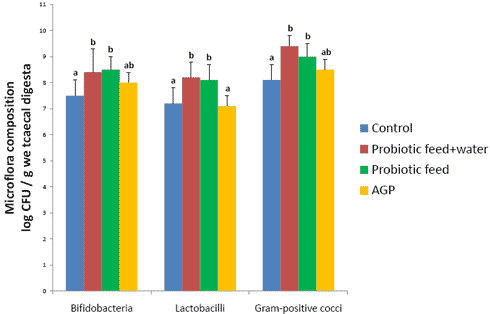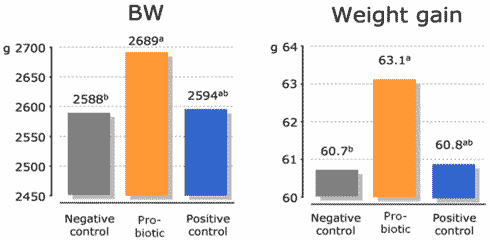



Probiotics in Poultry and Pig Nutrition: Basics and Benefits
An introduction to the topic by Dr Tobias Steiner of Biomin Holding GmbH, including mode of action and examples of how probiotics can affect poultry and pig performance.Characterisation
Since the importance of a well-balanced gut microflora for adequate health and high performance has been recognised, feeding strategies have been directed to control the microbial gastrointestinal environment by nutritional means. One key strategy is to feed directly the microorganisms which are supposed to exert beneficial effects in the gut. Probiotics are live microorganisms which are supplemented to the feed in order to establish a beneficial gut microflora (Fuller, 1989). Thus, probiotics have the potential to beneficially affect gut health by modification of the gut microflora, especially in young animals, in which a stable gut microflora is not yet established.
Microorganisms Used as Probiotics in Animal Nutrition
In human nutrition, lactobacilli and bifidobacteria are frequently included in yoghurts and other milk products. However, due to their poor stability during storage, their application in animal nutrition is rather limited. Probiotic feed additives generally consist of one single strain or a combination of several strains of bacteria, Bacillus spores or yeasts species (multi-strain). Preparations authorised for use in animal nutrition in the European Union include different strains of Enterococcus, Bacillus, Lactobacillus, Pediococcus or Saccharomyces.
How Probiotics Work
The mode of action of probiotic feed additives is mainly based on three principles:
- Competitive exclusion
- Bacterial antagonism, and
- Immune modulation
The benefit of probiotics with respect to health status and performance is expected to be highest in young animals such as piglets, newly-hatched chickens or calves, because these animals have not yet developed a stable gut microflora. Moreover, when animals undergo therapeutic treatment of diseases with antibiotics, the gut microflora is generally decimated. Therefore, administration of probiotics after antibiotic treatment assists in re-establishing a beneficial gut microflora to prevent the host from recurrent pathogenic colonisation.
Competitive exclusion
The concept of competitive exclusion indicates that cultures of selected, beneficial microorganisms, supplemented to the feed, compete with potentially harmful bacteria in terms of adhesion sites and organic substrates (mainly carbon and energy sources). Probiotics may colonise and multiply in the gut, thereby blocking receptor sites and preventing the attachment of other bacteria including harmful species such as enteropathogenic E. coli or Salmonella. Undoubtedly, probiotics have the potential to decrease the risk of infections and intestinal disorders. As shown in in vitro studies by Hillman et al. (1995), growth of enterotoxic E. coli was successfully inhibited by different strains of Lactobacilli. As reported by Berchieri et al. (2006), a combination of different lactic acid bacteria significantly reduced the levels of Salmonella enteritidis in caecal contents of broilers which had been orally inoculated with the pathogen. In piglets, attachment of enterotoxic E. coli to the small intestinal epithelium was inhibited by dietary supplementation with Enterococcus faecium (Jin et al., 2000).
Bacterial antagonism
Probiotic microorganisms, once established in the gut, may produce substances with bactericidal or bacteriostatic properties (bacteriocins) such as lactoferrin, lysozyme, hydrogen peroxide as well as several organic acids. These substances have a detrimental impact on harmful bacteria, which is primarily due to a lowering of the gut pH (Kelly and King, 2001; Conway, 1996). A decrease in pH may partially offset the low secretion of hydrochloric acid in the stomach of weanling piglets. In addition, competition for energy and nutrients between probiotic and other bacteria may result in a suppression of pathogenic species (Ewing and Cole, 1994). The impact of probiotics, applied though feed or feed and drinking water, in comparison to AGPs on gut microflora of broilers has been demonstrated by Mountzouris et al. (2006) (Figure 1). In total 400 day old broilers were fed corn-soybean meal-based diets with or without supplementation of either a newly-developed multi-strain probiotic feed additive based on Lactobacilli, Bifidobacteria, Enterococcus and Pediococcus (PoultryStar) or a commercial antibiotic growth promoter (AGP, Avilamycin). Compared to the control and AGP treatment, the probiotic additive significantly increased the numbers of beneficial Bifidobacteria, Lactobacilli and Gram-positive cocci. Moreover, growth performance in birds fed supplemental synbiotics was similar as compared to birds fed the AGP.

(adapted from Mountzouris et al., 2006)
Immune modulation
The development and activation of the humoral and cellular gut-associated immune system is largely affected by the development of the gut microflora (Cebra, 1999). According to Lan et al. (2005), microbial communities can support the animal's defence against invading pathogens by stimulating gastrointestinal immune response.
Effects of Probiotics on Poultry Performance
Addition of probiotics has shown beneficial effects on growth performance of poultry. In broilers supplementation of a control diet with probiotics based on Bacillus cereus or Saccharomyces boulardii improved feed conversion rate by 12 and 11 per cent, respectively (Gil de los Santos et al., 2005). Moreover, after 47 days, average live weight was significantly higher (16 and 7 per cent, respectively) in birds fed the two types of probiotics in comparison to the control group. The effect on growth performance of the same probiotic preparation was investigated in a study with 200 day-old broilers (Mohnl et al., 2006). Administration of the multi-strain probiotic (PoultryStar) in the drinking water significantly improved live weight (4 per cent) and daily weight gain (4 per cent) (Figure 2) and numerically reduced mortality rate (48 per cent) in comparison with a negative control.

a.b Significant difference between treatments (P<0.05)
In turkeys, Männer et al. (2002) reported a 1.5 and 2.0 per cent improvement in average daily weight gain and feed conversion rate, respectively, when diets were supplemented with a blend of different probiotic strains originating from Bacillus or Enterococcus. Furthermore, mortality rate was decreased by 16 per cent in birds fed supplemental probiotics. In a study by Mountzouris et al. (2006) with broilers, the above mentioned multi-strain probiotic additive also increased average daily weight gain and feed efficiency (by three and two per cent, respectively, in two applications).
Effects of Probiotics on Pig Performance
According to Zani et al. (1998), supplementation of diets with a probiotic preparation based on Bacillus cereus significantly improved daily weight gain and feed conversion ratio by 24 and 19 per cent, respectively. In another trial with piglets (Kyriakis et al., 1999), addition of probiotics originating from Bacillus licheniformis to a control diet improved average daily weight gain as well. Moreover, the incidence and severity of diarrhoea as well as mortality rate were significantly decreased in a study by Kyriakis et al. (1999). Shim (2005) fed a two- or multi-strain probiotic feed additive to growing pigs and observed significant improvements in average daily weight gain and feed efficiency as well. Additionally, administration of the multi-strain probiotic tended to cause higher weight gain and feed efficiency in comparison to the two-strain probiotic, indicating a synergistic effect of different probiotic strains under in vivo conditions.
Conclusion
Probiotics have great potential to beneficially affect the gut microflora and hence improve gut health in non-ruminants. Recent data confirms that a combination of several bacterial strains in a 'multi-strain' preparation is highly efficient in poultry feeding.
November 2009








